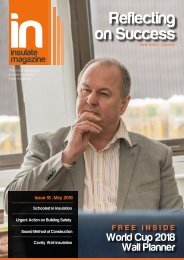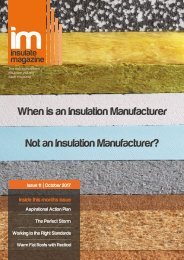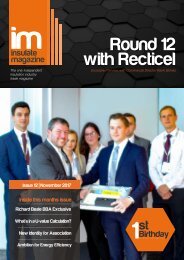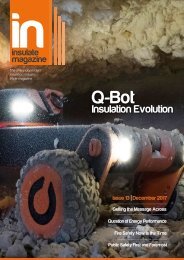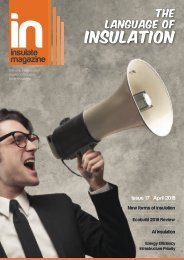Insulate Magazine Ecobuild 2018 Special Edition
Ecobuild 2018 special edition of Insulate Magazine, featuring Insulate exclusive articles and excellent insulation insight from Mauer, BBA, Insulation Superstore, Isover, NIA, Netsezch, 3M, IMA, Quinn, MIMA,
Ecobuild 2018 special edition of Insulate Magazine, featuring Insulate exclusive articles and excellent insulation insight from Mauer, BBA, Insulation Superstore, Isover, NIA, Netsezch, 3M, IMA, Quinn, MIMA,
Create successful ePaper yourself
Turn your PDF publications into a flip-book with our unique Google optimized e-Paper software.
www.insulatenetwork.com<br />
Exclusive <strong>Insulate</strong> Column<br />
Driving Up Quality<br />
Paul Forrester Technical Editor, <strong>Insulate</strong> <strong>Magazine</strong><br />
Car manufacturers have long sold their<br />
products on the basis of fuel efficiency and<br />
emissions, despite most paying customers<br />
knowing they won’t achieve those figures. Similar<br />
awareness doesn’t yet exist for people looking to<br />
buy a new home, but do changes in the automotive<br />
industry hint at a different future in construction?<br />
A 2014 edition of Audi <strong>Magazine</strong>, the customer magazinestomer<br />
of Audi UK, carried an article about fuel performance<br />
and carbon dioxide emissions figures for cars. As well as<br />
describing how the tests are carried out, there was also an<br />
explanation of the usefulness of the results.<br />
It made for interesting reading, not least because of the<br />
openness with which it talked about how little relevance<br />
the test figures had for what would be achieved on the<br />
road. The other striking thing about the piece was how<br />
much resemblance its content bore to the construction industry.<br />
Controlled Conditions<br />
Tests must be “in strict adherence with European guidelines”<br />
and have to be done in laboratory conditions because<br />
the “infinite variations” in road conditions, weather<br />
and driving style would make it impossible to test one vehicle<br />
against another in the real world.<br />
The in-situ testing of construction is almost non-existent,<br />
with assessment being based around software, paperwork<br />
and the limited policing of translating design intent to site.<br />
Statements such as, “it is not practical to test every new<br />
car” brought to mind building regulations that allow acoustic<br />
or air pressure testing of a sample of dwelling types.<br />
In explaining how the figures are “for guidance only” - but<br />
that they allow for a comparison between models from one<br />
manufacturer or different manufacturers - it was impossible<br />
not to think of SAP and SBEM calculations being used<br />
to assess building compliance, and Energy Performance<br />
Certificates rating performance without accounting for occupant<br />
behaviour.<br />
Uncovering Truth<br />
Of course, not long after the article’s publication, the<br />
Volkswagen Group became engulfed in a scandal of its<br />
own making through the revelations that it cheated emissions<br />
tests.<br />
With hindsight, it’s easy to be sceptical about any apparent<br />
good intent in the magazine article because Audi is<br />
part of the VW Group. In truth, however, any car manufacturer<br />
could have written it, so the validity of comparisons<br />
between the automotive and construction industries isn’t<br />
diminished.<br />
If anything, the existence of an even bigger performance<br />
gap between a car’s lab results and road performance only<br />
serves to make the comparisons more relevant.<br />
The reality of building performance is that energy use is<br />
typically 30% higher once constructed than was predicted<br />
at design stage. That is far too big a discrepancy to be explained<br />
away by ‘infinite variations’ of occupant behaviour,<br />
or site location and weather conditions.<br />
Strength of Feeling<br />
Once the full extent of the VW scandal became clear, it<br />
was not uncommon to hear suggestions that the performance<br />
of buildings - and housing specifically - should be<br />
highlighted as a similar scandal in an effort to raise public<br />
awareness.<br />
How outraged were people really, though? In 2016, the<br />
VW Group became the number one car manufacturer in<br />
the world in terms of sales.<br />
24<br />
24<br />
www.insulatenetwork.com





